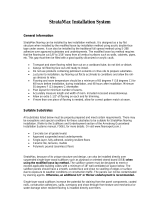
159Chapter V — Installation Systems
■ When using S-230, remove any existing adhesive residue* so that 80%
of the overall area of the original substrate is exposed. If these
requirements are not followed, curled and/or loose tile could result. For
Tile-On, remove wax or other finishes with a commercially available liquid
wax stripper. Replace or repair indented or otherwise damaged areas.
■ Allow all flooring materials and adhesives to condition to the room
temperature a minimum of 48 hours before starting the installation.
■ The area to receive resilient flooring should be maintained at a minimum
of 65°F (18°C) and a maximum of 100°F (38°C) for 48 hours before, during
and for 48 hours after completion. When using S-230 Epoxy Adhesive the
maximum room temperature should not exceed 85°F (29°C).
■ During the service life of the floor the temperature should never fall below
55°F (13°C). The performance of the flooring material and adhesives can be
adversely affected below this minimum temperature.
■ Conduct calcium chloride tests or percent relative humidity tests. Bond
Tests should also be conducted for compatibility with the substrate. Please
refer to Chapter IV, Subfloors and Underlayments.
■ Radiant-heated substrates must not exceed a maximum surface
temperature of 85°F (29°C).
■ Concrete floors should be tested for alkalinity. The allowable readings for
the installation of Armstrong flooring are 5 to 9 on the pH scale.
Fitting:
See Chapter VII, Layout and Fitting, for room layout.
Before installing the material, plan the layout so tile joints fall at least 6″ (15.2 cm)
away from subfloor/underlayment joints. Do not install over expansion joints.
When installing over an existing resilient floor, plan the layout so the new
joints are a minimum of 6″ (15.2 cm) away from the original seams. When
installing over tile floors, joints should fall in the center of the tile.
When installing 12″ × 12″ (30.5 cm × 30.5 cm) tiles, avoid having border pieces
less than 6″ (15.2 cm) wide.
Abutting Different Gauges of Resilient Flooring: When installing thinner
gauge material next to thicker gauge materials, install thicker material first and
then butt a 12″ (30.5 cm) wide piece of S-153 Scribing Felt against the thicker
material. Adhere the Scribing Felt to the subfloor with S-235 Adhesive. Use the
fine notching of the Armstrong S-891 Trowel over nonporous substrates such
as existing resilient flooring, and use the regular notching of the Armstrong
S-891 Trowel over porous subfloors such as wood and concrete. Use
Armstrong S-184 Fast-Setting Cement-Based Patch and Skim Coat or S-194
Patch, Underlayment and Embossing Leveler to feather the edge of the S-153
Scribing Felt to the level of the substrate. Allow the patch to dry completely
before installing the flooring. Scribing Felt is not recommended to be used
under the entire installation.
* Some previously manufactured asphaltic “cutback” adhesives contained asbestos (see warning
statement on page xii). For removal instructions, refer to the Resilient Floor Covering Institute’s
publication Recommended Work Practices for Removal of Resilient Floor Coverings.





